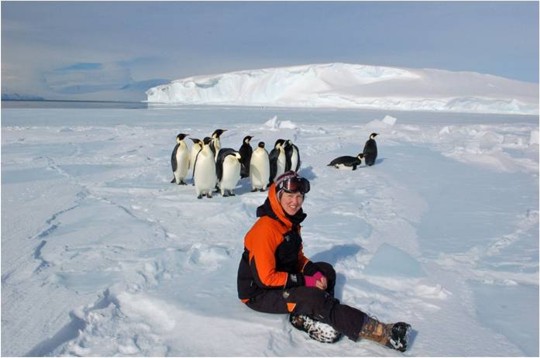Jane Chewings
“It was one of those ‘pinch me, did that just happen?’ moments” for Jane Chewings when she was given the opportunity to do fieldwork in Antarctica. Taking on a Masters degree in geology allowed Jane to further explore her interest in sedimentary geology and made her long-held dream of going to “The Ice”come true.

For Jane’s Masters she created a sedimentation model for the aeolian (wind-blown) sediment (or ‘dust’) that is transported from exposed, ice-free areas in McMurdo Sound to the Ross Sea.
“Due to its extreme aridity and freezing temperatures, Antarctica has no running water to erode the land and transport sediments to the sea. Because of this, ice is the major agent of erosion for the continent. However, where ice-free areas persist, such as the McMurdo Dry Valleys, wind becomes an important modifying force” says Jane.
“Aeolian dust gets trapped in snowdrifts on the surface of the sea ice each winter and is later dumped into the ocean in significant volumes when the sea ice melts in the summer. The basis of my research is a dataset of snow samples that I helped to collect from the sea ice in McMurdo Sound”, explains Jane.
“Gaining a better picture of the role aeolian processes have in the transportation and deposition of dust particles to the sea in this area will help with the interpretation of cores retrieved from the seafloor by geological drilling projects such as ANDRILL. This research will also aid ocean productivity studies in the Ross Sea that question the biogeochemical links between dust and phytoplankton blooms.
“Aeolian processes and the contribution they make to the geological system have been little studied in Antarctica. My Masters project will be contributing new information to the wider scientific community, which is something I’m excited about”.
Jane was in her thirties when she came back to study after having worked for nearly a decade in the New Zealand arts industry. Her whole world view has altered since she began studying Earth Science. She now thinks in geological time. “When you look at geological processes over a longer timeframe than a human lifespan, you begin to see how much of an impact human activity is having on the planet” says Jane. She also thinks New Zealand is one of the best places to study geology in the world due to its active and (geologically) young landscape. “We have a very dynamic backyard. Geological processes that form and alter the solid earth have been occurring globally for billions of years. New Zealand's location over a dynamic tectonic plate boundary means we can see these processes still very much in action.”
Jane now works as the Technician - Sedimentology in the School of Geography, Environment and Earth Sciences.
